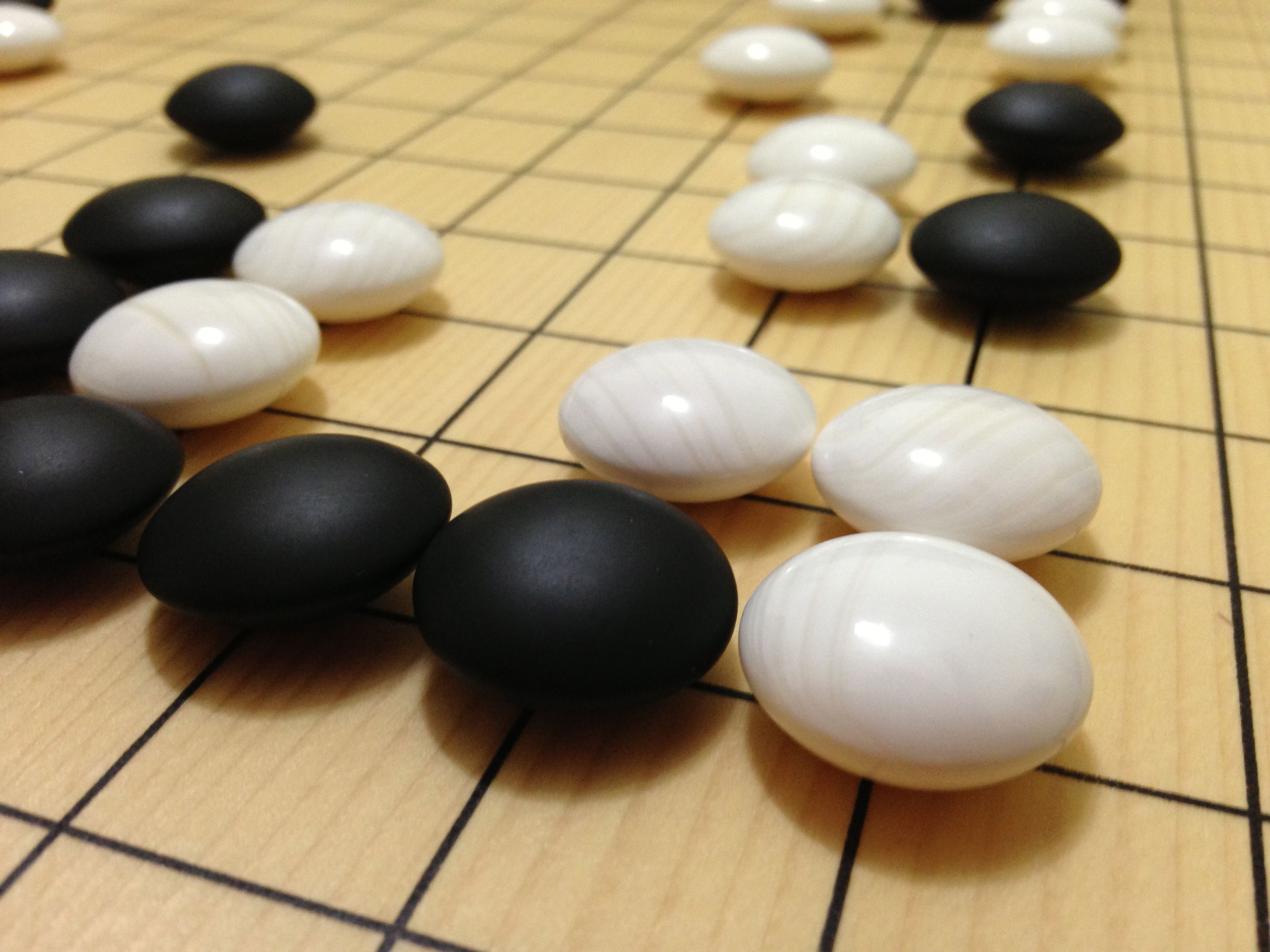
Go
2 - 2 persone
30 - 180 min
8+
Al momento questo prodotto non è disponibile presso nessun venditore.
Nomi alternativi: Atari Go, Baduk, Cờ Vây, The Game of Go, Gó, Go, Go & Go Bang Turnier, Go & Gobang, Go + Gobang, Go A Game of Oriental Strategy, Go Gobang, The Go Pack, Go und Gobang, Go, Das Brettspiel Ostasiens, GoToGo, Igo, Jang Stone II, Jeu de Go, Magnetic Chess, Magnetic GO, Mikado: The Game of Go, Negociation, Orient, The Oriental Game of Go, Original Go, Paduk, Patol, Peg Travel Go Game, Smart Go, U3 English edition, Wei Qi, Weichi, Weiqi, yi, yih, Yunzi Go Stone set, Вэйци, Го, Падук, 囲碁, 围棋, 圍棋, 弈, 碁, 바둑, 신의한수
Artisti: Barbro Hennius, Norman Sommer
Editori: (Public Domain), (Unknown), 3M, Alga, Ariel Productions Ltd, The Avalon Hill Game Co, Barnes & Noble, Borras Plana S.A., Brybelly, Carl Weible KG, Carlton Books, Cathay, Cayro, The Games, CHH Games, Copp Clark Publishing Company, Creative Crafthouse, Crisloid, Dal Negro, Dilemma Games, Dujardin, Dynamic Games / Dynamic Design Industries, E. S. Lowe Company Inc., Fame Products, Fratelli Fabbri Editori (Fabbri Editore), The Game Crafter, LLC, The Game Keeper, Inc., Gamma Two Games, Gammon Games, General Sportcraft Company, Gentosha Education, Geoludie, Ha Ha Sisters LLC, Hartung-Spiele, Hausser, Hebsacker Verlag, HEMA, Hobby, Ishi Press International, J.P. Raymond Rivarola, Japan Publications, Inc., John N. Hansen Co., Inc., John Sands Pty Ltd, Jumbo, Korea Boardgames, L. P. Septu00edmio, L'Impensu00e9 Radical, Longfield Games, Ludens Spirit, Michael Stanfield, Milton Bradley, Mitra, Mitsubishi Fuso, Monkey Pod Games, nestorgames, Otto Maier Verlag, Pacific Game Company, Philos, Play All Day Games, Ponnuki, Reiss Games, Sato Kei Shoten Co., Ltd., Schmidt International, Schmidt Spiele, Shin Kwang Baduk, Skor-Mor, Spear's Games, Das Spiel, Spielquader, U3, Volume-One Products, Waddingtons, Wm F. Drueke & Sons, Inc., Wood Expressions, Woodstock Spiele, WorldWise Imports, LLC, Yellow Mountain Imports, ZTS Plastyk
Editori: (Public Domain), (Unknown), 3M, Alga, Ariel Productions Ltd, The Avalon Hill Game Co, Barnes & Noble, Borras Plana S.A., Brybelly, Carl Weible KG, Carlton Books, Cathay, Cayro, The Games, CHH Games, Copp Clark Publishing Company, Creative Crafthouse, Crisloid, Dal Negro, Dilemma Games, Dujardin, Dynamic Games / Dynamic Design Industries, E. S. Lowe Company Inc., Fame Products, Fratelli Fabbri Editori (Fabbri Editore), The Game Crafter, LLC, The Game Keeper, Inc., Gamma Two Games, Gammon Games, General Sportcraft Company, Gentosha Education, Geoludie, Ha Ha Sisters LLC, Hartung-Spiele, Hausser, Hebsacker Verlag, HEMA, Hobby, Ishi Press International, J.P. Raymond Rivarola, Japan Publications, Inc., John N. Hansen Co., Inc., John Sands Pty Ltd, Jumbo, Korea Boardgames, L. P. Septu00edmio, L'Impensu00e9 Radical, Longfield Games, Ludens Spirit, Michael Stanfield, Milton Bradley, Mitra, Mitsubishi Fuso, Monkey Pod Games, nestorgames, Otto Maier Verlag, Pacific Game Company, Philos, Play All Day Games, Ponnuki, Reiss Games, Sato Kei Shoten Co., Ltd., Schmidt International, Schmidt Spiele, Shin Kwang Baduk, Skor-Mor, Spear's Games, Das Spiel, Spielquader, U3, Volume-One Products, Waddingtons, Wm F. Drueke & Sons, Inc., Wood Expressions, Woodstock Spiele, WorldWise Imports, LLC, Yellow Mountain Imports, ZTS Plastyk
Descrizione: By all appearances, it's just two players taking turns laying stones on a 19×19 (or smaller) grid of intersections. But once its basic rules are understood, Go shows its staggering depth. One can see why many people say it's one of the most elegant brain-burning abstract games in history, with players trying to claim territory by walling off sections of the board and surrounding each other's stones. The game doesn't end until the board fills up, or, more often, when both players agree to end it, at which time whoever controls the most territory wins.
The earliest mention of Go (圍棋 (wéi qí)- "surrounding game") appears in the "Analects" of Confucius (551-479 BC), while the earliest physical evidence is a 17×17 Go board discovered in 1952 in a tomb of the former Han dynasty (206 BC- 9 AD). There is a tangle of conflicting popular and scholarly anecdotes attributing its invention to two Chinese emperors, an imperial vassal and court astrologers. One story has it that Go was invented by the legendary Emperor Yao (ruled 2357-2256 BC) as an amusement for his idiot son. A second claims that the Emperor Shun (ruled 2255-2205 BC) created the game in hopes of improving his weak-minded son's mental prowess. A third says the person named Wu, a vassal of the Emperor Jie (ruled 1818-1766 BC), invented Go (as well as games of cards). Finally, a fourth story suggests that Go was developed by court astrologers during the Zhou dynasty (1045-255 BC).
A Go set, consisting of a very general-purpose grid and colored stones, can also be used to play a variety of other abstract strategy games, such as Connect6, Go-Moku, and Pente.
The earliest mention of Go (圍棋 (wéi qí)- "surrounding game") appears in the "Analects" of Confucius (551-479 BC), while the earliest physical evidence is a 17×17 Go board discovered in 1952 in a tomb of the former Han dynasty (206 BC- 9 AD). There is a tangle of conflicting popular and scholarly anecdotes attributing its invention to two Chinese emperors, an imperial vassal and court astrologers. One story has it that Go was invented by the legendary Emperor Yao (ruled 2357-2256 BC) as an amusement for his idiot son. A second claims that the Emperor Shun (ruled 2255-2205 BC) created the game in hopes of improving his weak-minded son's mental prowess. A third says the person named Wu, a vassal of the Emperor Jie (ruled 1818-1766 BC), invented Go (as well as games of cards). Finally, a fourth story suggests that Go was developed by court astrologers during the Zhou dynasty (1045-255 BC).
A Go set, consisting of a very general-purpose grid and colored stones, can also be used to play a variety of other abstract strategy games, such as Connect6, Go-Moku, and Pente.
